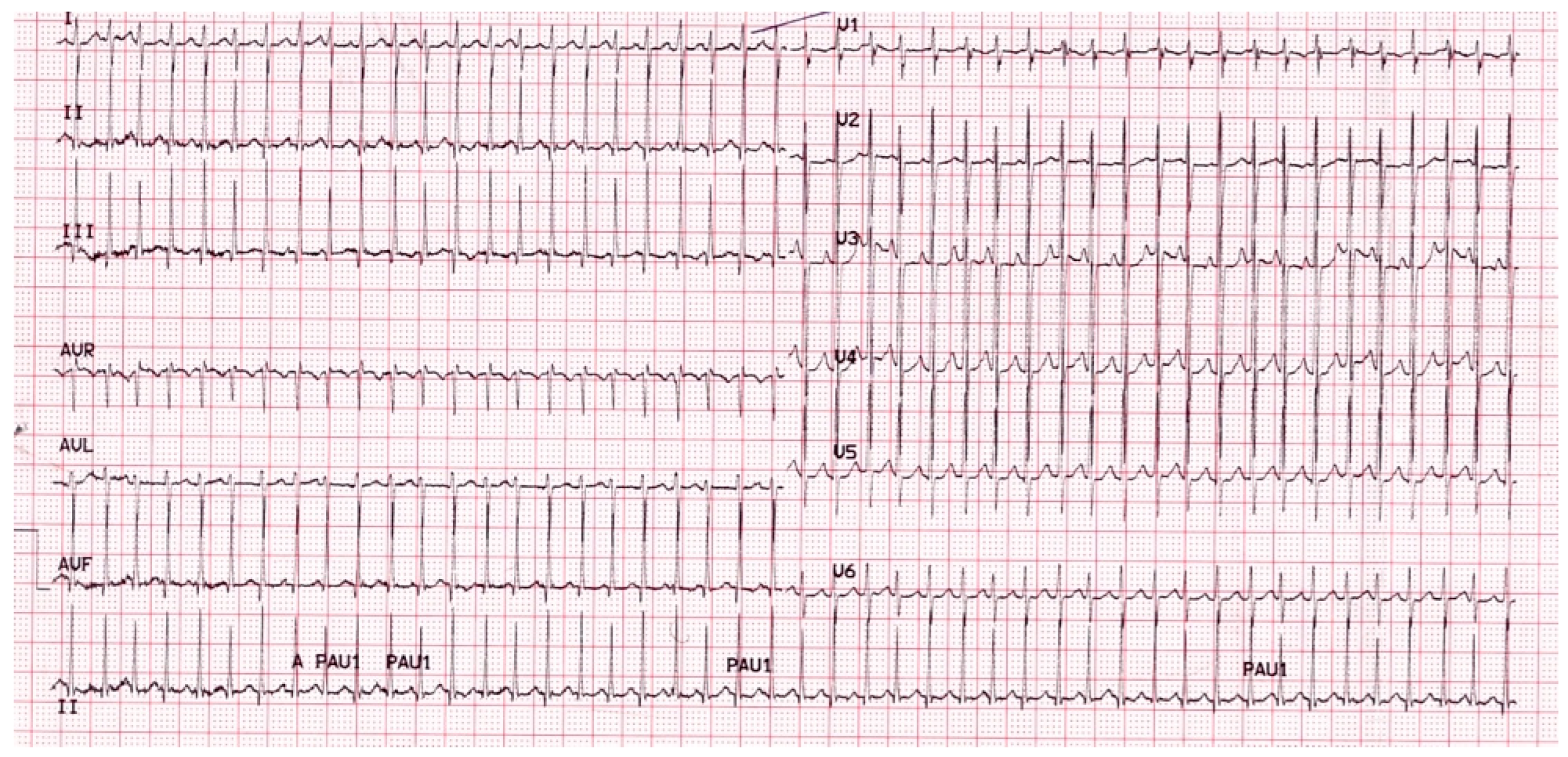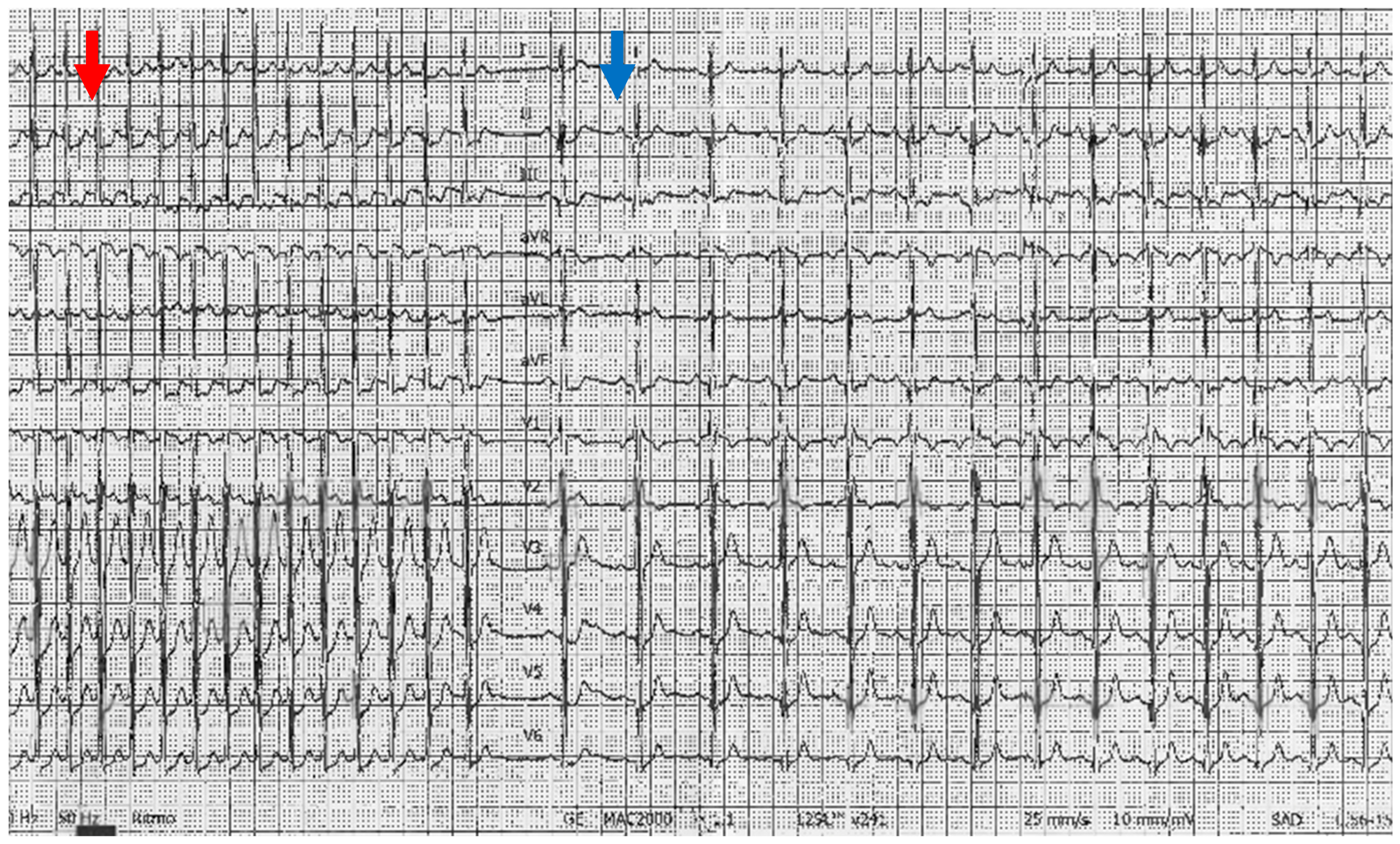Inhaled Short-Acting Beta Agonist Treatment-Associated Supraventricular Tachycardia in Children: Still a Matter of Concern in Pediatric Emergency Departments?
Abstract
:1. Introduction
2. Case Reports
2.1. Patient 1
2.2. Patient 2
2.3. Patient 3
3. Discussion
4. Conclusions
Author Contributions
Funding
Institutional Review Board Statement
Informed Consent Statement
Data Availability Statement
Conflicts of Interest
References
- Roemer, M. Health Care Expenditures for the Five Most Common Children’s Conditions, 2008: Estimates for U.S. Civilian Noninstitutionalized Children, Ages 0-17; Agency for Healthcare Research and Quality: Rockville, MD, USA, 2011.
- National Asthma Education and Prevention Program. Guidelines for the Diagnosis and Management of Asthma; National Heart Lung and Blood Institute, National Institutes of Health, U.S. Department of Health and Human Services: Bethesda, MD, USA, 2007.
- Indinnimeo, L.; Chiappini, E.; Miraglia Del Giudice, M. Italian Panel for the management of acute asthma attack in children Roberto Bernardini. Guideline on management of the acute asthma attack in children by Italian Society of Pediatrics. Ital. J. Pediatr. 2018, 44, 46. [Google Scholar] [CrossRef]
- Bozzola, E.; Bozzola, M.; Barberi, S.; Cutrera, R.; Villani, A. Safety and potential side effects of beta 2-agonists: A still debated question. Int. J. Pediatr. Child Health 2013, 1, 4–10. [Google Scholar] [CrossRef]
- Perry, J.C. Supraventricular tachycardia. In Science and Practice of Pediatric Cardiology, 2nd ed.; Garson, A., Jr., Bricker, J.T., Fisher, D.J., Neish, S.R., Eds.; Williams and Wilkins: Baltimore, MD, USA, 1998; p. 2059. [Google Scholar]
- Nadas, A.S.; Daeschner, C.W.; Roth, A.; Blumenthal, S.L. Paroxysmal tachycardia in infants and children; study of 41 cases. Pediatrics 1952, 9, 167–181. [Google Scholar]
- Garson, A.; Gillette, P.C. Electrophysiologic studies of supraventricular tachycardia in children. I. Clinical-electrophysiologic correlations. Am. Heart J. 1981, 102, 233–250. [Google Scholar] [CrossRef]
- Losek, J.D.; Endore, E.; Dietrich, A.; Stewart, G.; Zempsky, W.; Smith, K. Adenosine and pediatric supraventricular tachycardia in the emergency department: Multicenter study and review. Ann. Emerg. Med. 1999, 33, 185–191. [Google Scholar] [CrossRef] [PubMed]
- Gilljam, T.; Jaeggi, E.; Gow, R.M. Neonatal supraventricular tachycardia: Outcomes over a 27-year period at a single institution. Acta Paediatr. 2008, 97, 1035–1039. [Google Scholar] [CrossRef]
- Cain, N.; Irving, C.; Webber, S.; Beerman, L.; Arora, G. Natural history of Wolff-Parkinson-White syndrome diagnosed in childhood. Am. J. Cardiol. 2013, 112, 961–965. [Google Scholar] [CrossRef] [PubMed]
- Hedrick, J.A.; Baker, J.W.; Atlas, A.B.; Naz, A.A.; Lincourt, W.R.; Trivedi, R.; Ellworth, A.; Davis, A.M. Safety of daily albuterol in infants with a history of bronchospasm: A multi-center placebo-controlled trial. Open Respir. Med. J. 2009, 3, 100–106. [Google Scholar] [CrossRef] [Green Version]
- Wong, C.S.; Pavord, I.D.; Williams, J.; Britton, J.R.; Tattersfield, A.E. Bronchodilator, cardiovascular, and hypokalaemic effects of fenoterol, salbutamol, and terbutaline in asthma. Lancet 1990, 336, 1396–1399. [Google Scholar] [CrossRef]
- Flatt, A.; Crane, J.; Purdie, G.; Kwong, T.; Beasley, R.; Burgess, C. The cardiovascular effects of beta-adrenergic agonist drugs administered by nebulisation. Postgrad. Med. J. 1990, 66, 98–101. [Google Scholar] [CrossRef] [Green Version]
- Kallergis, E.M.; Manios, E.G.; Kanoupakis, E.M.; Schiza, S.E.; Mavrakis, H.E.; Klapsinos, N.K.; Vardas, P.E. Acute electrophysiologic effects of inhaled salbutamol in humans. Chest 2005, 127, 2057–2063. [Google Scholar] [CrossRef] [PubMed] [Green Version]
- Cook, P.; Scarfone, R.J.; Cook, R.T. Adenosine in the termination of albuterol-induced supraventricular tachycardia. Ann. Emerg. Med. 1994, 24, 316–319, Erratum in Ann. Emerg. Med. 1995, 25, 119. [Google Scholar] [CrossRef] [PubMed]
- Keller, K.A.; Bhisitkul, D.M. Supraventricular tachycardia: A complication of nebulized albuterol. Pediatr. Emerg. Care 1995, 11, 98–99. [Google Scholar] [CrossRef] [PubMed]
- Duane, M.; Chandran, L.; Morelli, P.J. Recurrent supraventricular tachycardia as a complication of nebulized albuterol treatment. Clin. Pediatr. 2000, 39, 673–677. [Google Scholar] [CrossRef]
- Kroesen, M.; Maseland, M.; Smal, J.; Reimer, A.; van Setten, P. Probable association of tachyarrhythmia with nebulized albuterol in a child with previously subclinical Wolff Parkinson White syndrome. J. Pediatr. Pharmacol. Ther. 2012, 17, 93–97. [Google Scholar] [CrossRef]
- Woodward, S.; Mundorff, M.; Weng, C.; Gamboa, D.G.; Johnson, M.D. Incidence of supraventricular tachycardia after inhaled short-acting beta agonist treatment in children. J. Asthma 2021, 58, 471–480. [Google Scholar] [CrossRef] [PubMed]
- Leung, J.S.; Johnson, D.W.; Sperou, A.J.; Crotts, J.; Saude, E.; Hartling, L.; Stang, A. A systematic review of adverse drug events associated with administration of common asthma medications in children. PLoS ONE 2017, 12, e0182738. [Google Scholar] [CrossRef] [Green Version]
- Cazzola, M.; Matera, M.G.; Donner, C.F. Inhaled beta2-adrenoceptor agonists: Cardiovascular safety in patients with obstructive lung disease. Drugs 2005, 65, 1595–1610. [Google Scholar] [CrossRef]
- Al-Hillawi, A.H.; Hayward, R.; Johnson, N.M. Incidence of cardiac arrhythmias in patients taking slow-release salbutamol and slow release terbutaline for asthma. Br. Med. J. (Clin. Res. Ed.) 1984, 288, 367. [Google Scholar] [CrossRef] [Green Version]
- Brodde, O.E. Beta 1- and beta 2-adrenoceptors in the human heart: Properties, function, and alterations in chronic heart failure. Pharmacol. Rev. 1991, 43, 203–242, Erratum in Pharmacol. Rev. 1991, 43, 350. [Google Scholar]
- Xiao, R.P.; Cheng, H.; Zhou, Y.Y.; Kuschel, M.; Lakatta, E.G. Recent advances in cardiac beta (2)-adrenergic signal transduction. Circ. Res. 1999, 85, 1092–1100. [Google Scholar] [CrossRef] [PubMed] [Green Version]
- Rodefeld, M.D.; Beau, S.L.; Schuessler, R.B.; Boineau, J.P.; Saffitz, J.E. Beta-adrenergic and muscarinic cholinergic receptor densities in the human sinoatrial node: Identification of a high beta 2-adrenergic receptor density. J. Cardiovasc. Electrophysiol. 1996, 7, 1039–1049. [Google Scholar] [CrossRef]
- Snyder, E.M.; Wong, E.C.; Foxx-Lupo, W.T.; Wheatley, C.M.; Cassuto, N.A.; Patanwala, A.E. Effects of an inhaled β2-agonist on cardiovascular function and sympathetic activity in healthy subjects. Pharmacotherapy 2011, 31, 748–756. [Google Scholar] [CrossRef] [PubMed]
- Kaashmiri, M.; Shepard, J.; Goodman, B.; Lincourt, W.R.; Trivedi, R.; Ellsworth, A.; Davis, A.M. Repeat dosing of albuterol via metered-dose inhaler in infants with acute obstructive airway disease: A randomized controlled safety trial. Pediatr. Emerg. Care 2010, 26, 197–202. [Google Scholar] [CrossRef] [PubMed]
- Newton, G.E.; Parker, J.D. Acute effects of β1-selective and nonselective β-adrenergic receptor blockade on cardiac sympathetic activity in congestive heart failure. Circulation 1996, 94, 353–358. [Google Scholar] [CrossRef] [PubMed]
- Brodde, O.E.; Michel, M.C. Adrenergic and muscarinic receptors in the human heart. Pharmacol. Rev. 1999, 51, 651–690. [Google Scholar] [PubMed]
- Fagbuyi, D.B.; Venkataraman, S.; Ralphe, J.C.; Zuckerbraun, N.S.; Pitetti, R.D.; Lin, Y.; Jeong, K.; Saladino, R.A.; Manole, M.D. Diastolic Hypotension, Troponin Elevation, and Electrocardiographic Changes Associated with the Management of Moderate to Severe Asthma in Children. Acad. Emerg. Med. 2016, 23, 816–822. [Google Scholar] [CrossRef] [Green Version]
- Crane, J.; Burgess, C.; Beasley, R. Cardiovascular and hypokalaemic effects of inhaled salbutamol, fenoterol, and isoprenaline. Thorax 1989, 44, 136–140. [Google Scholar] [CrossRef] [Green Version]
- Sarnaik, S.M.; Saladino, R.A.; Manole, M.; Pitetti, R.A.; Arora, G.; Kuch, B.A.; Orr, R.A.; Felmet, K.A. Diastolic hypotension is an unrecognized risk factor for β-agonist-associated myocardial injury in children with asthma. Pediatr. Crit. Care Med. 2013, 14, e273–e279. [Google Scholar] [CrossRef]
- Wisecup, S.; Eades, S.; Hashmi, S.S.; Samuels, C.; Mosquera, R.A. Diastolic hypotension in pediatric patients with asthma receiving continuous albuterol. J. Asthma 2015, 52, 693–698. [Google Scholar] [CrossRef]
- Habashy, D.; Lam, L.T.; Browne, G.J. The administration of beta2-agonists for paediatric asthma and its adverse reaction in Australian and New Zealand emergency departments: A cross-sectional survey. Eur. J. Emerg. Med. 2003, 10, 219–224. [Google Scholar] [CrossRef] [PubMed]
- Milgrom, H.; Skoner, D.P.; Bensch, G.; Kim, K.T.; Claus, R.; Baumgartner, R.A. Levalbuterol Pediatric Study Group. Low dose levalbuterol in children with asthma: Safety and efficacy in comparison with placebo and racemic albuterol. J. Allergy Clin. Immunol. 2001, 108, 938–945. [Google Scholar] [CrossRef] [PubMed] [Green Version]
- Du Plooy, W.J.; Hay, L.; Kahler, C.P.; Schutte, P.J.; Brandt, H.D. The dose-related hyper-and-hypokalaemic effects of salbutamol and its arrhythmogenic potential. Br. J. Pharmacol. 1994, 111, 73–76. [Google Scholar] [CrossRef]
- Skoner, D.P.; Greos, L.S.; Kim, K.T.; Roach, J.M.; Parsey, M.; Baumgartner, R.A. Evaluation of the safety and efficacy of levalbuterol in 2-5-year-old patients with asthma. Pediatr. Pulmonol. 2005, 40, 477–486. [Google Scholar] [CrossRef] [PubMed]
- Yamamoto, T.; Yeh, S.J.; Lin, F.C.; Wu, D. Effects of isoproterenol on accessory pathway conduction in intermittent or concealed Wolff-ParkinsonWhite syndrome. Am. J. Cardiol. 1990, 65, 1438–1442. [Google Scholar] [CrossRef] [PubMed]
- Bonnin, A.J.; Richmond, G.W.; Musto, P.K.; Volgman, A.S.; Moy, J.N. Repeated inhalation of nebulized albuterol did not induce arrhythmias in a patient with Wolff-Parkinson-White syndrome and asthma. Chest 1993, 103, 1892–1894. [Google Scholar] [CrossRef] [PubMed]
- Bristow, M.R.; Ginsburg, R.; Umans, V.; Fowler, M.; Minobe, W.; Rasmussen, R.; Zera, P.; Menlove, R.; Shah, P.; Jamieson, S.; et al. Beta 1- and beta 2-adrenergic-receptor subpopulations in nonfailing and failing human ventricular myocardium: Coupling of both receptor subtypes to muscle contraction and selective beta 1-receptor down-regulation in heart failure. Circ. Res. 1986, 59, 297–309. [Google Scholar] [CrossRef] [Green Version]
- Johnson, M. Molecular mechanisms of beta (2)-adrenergic receptor function, response, and regulation. J. Allergy Clin. Immunol. 2006, 117, 18–24. [Google Scholar] [CrossRef]
- Caffarelli, C.; Calcinai, E.; Rinaldi, L.; Povesi Dascola, C.; Terracciano, L.; Corradi, M. Hydrogen peroxide in exhaled breath condensate in asthmatic children during acute exacerbation and after treatment. Respiration 2012, 84, 291–298. [Google Scholar] [CrossRef]
- Caffarelli, C.; Dascola, C.P.; Peroni, D.; Ricò, S.; Stringari, G.; Varini, M.; Folesani, G.; Corradi, M. Airway acidification in childhood asthma exacerbations. Allergy Asthma Proc. 2014, 35, 51–56. [Google Scholar] [CrossRef]
- Korantzopoulos, P.; Kolettis, T.M.; Galaris, D.; Goudevenos, J.A. The role of oxidative stress in the pathogenesis and perpetuation of atrial fibrillation. Int. J. Cardiol. 2007, 115, 135–143. [Google Scholar] [CrossRef] [PubMed]


| Patient 1 | Patient 2 | Patient 3 | |
|---|---|---|---|
| Age (years) | 11 | 2 | 10 |
| Gender | F | F | M |
| History | Allergic Asthma | Arrhythmias PSVT Allergic Asthma | Recurrent tachycardia |
| Dosage of salbutamol eliciting SVT | 2.5 mg by nebulizer | 100 mcg by pMDI with spacer | 300 mcg by pMDI with spacer |
| Conversion | Adenosine e.v. | Spontaneously | Spontaneously |
Disclaimer/Publisher’s Note: The statements, opinions and data contained in all publications are solely those of the individual author(s) and contributor(s) and not of MDPI and/or the editor(s). MDPI and/or the editor(s) disclaim responsibility for any injury to people or property resulting from any ideas, methods, instructions or products referred to in the content. |
© 2023 by the authors. Licensee MDPI, Basel, Switzerland. This article is an open access article distributed under the terms and conditions of the Creative Commons Attribution (CC BY) license (https://creativecommons.org/licenses/by/4.0/).
Share and Cite
Tchana, B.; Caffarelli, C. Inhaled Short-Acting Beta Agonist Treatment-Associated Supraventricular Tachycardia in Children: Still a Matter of Concern in Pediatric Emergency Departments? Children 2023, 10, 699. https://doi.org/10.3390/children10040699
Tchana B, Caffarelli C. Inhaled Short-Acting Beta Agonist Treatment-Associated Supraventricular Tachycardia in Children: Still a Matter of Concern in Pediatric Emergency Departments? Children. 2023; 10(4):699. https://doi.org/10.3390/children10040699
Chicago/Turabian StyleTchana, Bertrand, and Carlo Caffarelli. 2023. "Inhaled Short-Acting Beta Agonist Treatment-Associated Supraventricular Tachycardia in Children: Still a Matter of Concern in Pediatric Emergency Departments?" Children 10, no. 4: 699. https://doi.org/10.3390/children10040699
APA StyleTchana, B., & Caffarelli, C. (2023). Inhaled Short-Acting Beta Agonist Treatment-Associated Supraventricular Tachycardia in Children: Still a Matter of Concern in Pediatric Emergency Departments? Children, 10(4), 699. https://doi.org/10.3390/children10040699







